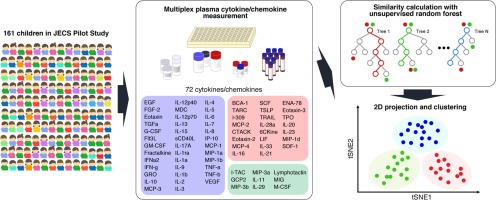Our official English website, www.x-mol.net, welcomes your feedback! (Note: you will need to create a separate account there.)
Exploratory analysis of plasma cytokine/chemokine levels in 6-year-old children from a birth cohort study
Cytokine ( IF 3.8 ) Pub Date : 2020-06-01 , DOI: 10.1016/j.cyto.2020.155051 Kiwako Yamamoto-Hanada 1 , Eiryo Kawakami 2 , Mayako Saito-Abe 1 , Miori Sato 1 , Hiroshi Mitsubuchi 3 , Masako Oda 3 , Takahiko Katoh 3 , Masafumi Sanefuji 4 , Shouichi Ohga 4 , Mari Kuwajima 4 , Nathan Mise 5 , Akihiko Ikegami 5 , Fujio Kayama 5 , Ayako Senju 6 , Masayuki Shimono 6 , Koichi Kusuhara 6 , Shin Yamazaki 7 , Shoji F Nakayama 7 , Kenji Matsumoto 8 , Hirohisa Saito 8 , Yukihiro Ohya 1
Cytokine ( IF 3.8 ) Pub Date : 2020-06-01 , DOI: 10.1016/j.cyto.2020.155051 Kiwako Yamamoto-Hanada 1 , Eiryo Kawakami 2 , Mayako Saito-Abe 1 , Miori Sato 1 , Hiroshi Mitsubuchi 3 , Masako Oda 3 , Takahiko Katoh 3 , Masafumi Sanefuji 4 , Shouichi Ohga 4 , Mari Kuwajima 4 , Nathan Mise 5 , Akihiko Ikegami 5 , Fujio Kayama 5 , Ayako Senju 6 , Masayuki Shimono 6 , Koichi Kusuhara 6 , Shin Yamazaki 7 , Shoji F Nakayama 7 , Kenji Matsumoto 8 , Hirohisa Saito 8 , Yukihiro Ohya 1
Affiliation

|
This study aimed to reveal a new dimension of allergy profiles in the general population by using machine learning to explore complex relationships among various cytokines/chemokines and allergic diseases (asthma and atopic dermatitis; AD). We examined the symptoms related to asthma and AD and the plasma levels of 72 cytokines/chemokines obtained from a general population of 161 children at 6 years of age who participated in a pilot birth cohort study of the Japan Environment and Children's Study (JECS). The children whose signs and symptoms fulfilled the criteria of AD, which are mostly based on questionnaire including past symptoms, tended to have higher levels of the two chemokine ligands, CCL17 and CCL27, which are used for diagnosis of AD. On the other hand, another AD-related chemokine CCL22 level in plasma was higher only in children with visible flexural eczema, which is one of AD diagnostic criteria but was judged on the same day of blood examination unlike other criteria. Here, we also developed an innovative method of machine learning for elucidating the complex cytokine/chemokine milieu related to symptoms of allergic diseases by using clustering analysis based on the random forest dissimilarity measure that relies on artificial intelligence (AI) technique. To our surprise, the majority of children showing at least any asthma-related symptoms during the last month were divided by AI into the two clusters, either cluster-2 having elevated levels of IL-33 (related to eosinophil activation) or cluster-3 having elevated levels of CXCL7/NAP2 (related to neutrophil activation), among the total three clusters. Future studies will clarify better approach for allergic diseases by endotype classification.
中文翻译:

一项出生队列研究中 6 岁儿童血浆细胞因子/趋化因子水平的探索性分析
本研究旨在通过使用机器学习探索各种细胞因子/趋化因子与过敏性疾病(哮喘和特应性皮炎;AD)之间的复杂关系,揭示一般人群过敏谱的新维度。我们检查了与哮喘和 AD 相关的症状以及从 161 名 6 岁儿童的一般人群中获得的 72 种细胞因子/趋化因子的血浆水平,这些儿童参加了日本环境与儿童研究 (JECS) 的先导出生队列研究。体征和症状符合 AD 标准的儿童(主要基于包括过去症状的问卷调查)往往具有较高水平的两种趋化因子配体 CCL17 和 CCL27,用于诊断 AD。另一方面,另一种AD相关趋化因子CCL22血浆中CCL22水平仅在可见弯曲湿疹的儿童中较高,这是AD诊断标准之一,但与其他标准不同,是在同一天的血液检查中判断的。在这里,我们还开发了一种创新的机器学习方法,通过使用基于人工智能 (AI) 技术的随机森林差异度量的聚类分析来阐明与过敏性疾病症状相关的复杂细胞因子/趋化因子环境。令我们惊讶的是,大多数在上个月至少表现出任何与哮喘相关的症状的儿童被 AI 分为两个集群,集群 2 的 IL-33 水平升高(与嗜酸性粒细胞激活相关)或集群 3 CXCL7/NAP2 水平升高(与中性粒细胞活化有关),在总共三个集群中。未来的研究将通过内型分类阐明过敏性疾病的更好方法。
更新日期:2020-06-01
中文翻译:

一项出生队列研究中 6 岁儿童血浆细胞因子/趋化因子水平的探索性分析
本研究旨在通过使用机器学习探索各种细胞因子/趋化因子与过敏性疾病(哮喘和特应性皮炎;AD)之间的复杂关系,揭示一般人群过敏谱的新维度。我们检查了与哮喘和 AD 相关的症状以及从 161 名 6 岁儿童的一般人群中获得的 72 种细胞因子/趋化因子的血浆水平,这些儿童参加了日本环境与儿童研究 (JECS) 的先导出生队列研究。体征和症状符合 AD 标准的儿童(主要基于包括过去症状的问卷调查)往往具有较高水平的两种趋化因子配体 CCL17 和 CCL27,用于诊断 AD。另一方面,另一种AD相关趋化因子CCL22血浆中CCL22水平仅在可见弯曲湿疹的儿童中较高,这是AD诊断标准之一,但与其他标准不同,是在同一天的血液检查中判断的。在这里,我们还开发了一种创新的机器学习方法,通过使用基于人工智能 (AI) 技术的随机森林差异度量的聚类分析来阐明与过敏性疾病症状相关的复杂细胞因子/趋化因子环境。令我们惊讶的是,大多数在上个月至少表现出任何与哮喘相关的症状的儿童被 AI 分为两个集群,集群 2 的 IL-33 水平升高(与嗜酸性粒细胞激活相关)或集群 3 CXCL7/NAP2 水平升高(与中性粒细胞活化有关),在总共三个集群中。未来的研究将通过内型分类阐明过敏性疾病的更好方法。



























 京公网安备 11010802027423号
京公网安备 11010802027423号